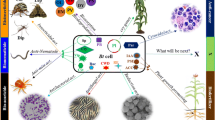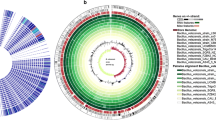Abstract
Erwinia carotovora, a widespread plant pathogen that causes soft rot disease in many plants, is considered a major threat in agriculture. Bacterial glutathione transferases (GSTs) play important roles in a variety of metabolic pathways and processes, such as the biodegradation of xenobiotics, protection against abiotic stress, and resistance against antimicrobial drugs. The GST family of canonical soluble enzymes from Erwinia carotovora subsp. atroseptica strain SCRI1043 (EcaGSTs) was investigated. Genome analysis showed the presence of six putative canonical cytoplasmic EcaGSTs, which were revealed by phylogenetic analysis to belong to the well-characterized GST classes beta, nu, phi, and zeta. The analysis also revealed the presence of two isoenzymes that were phylogenetically close to the omega class of GSTs, but formed a distinct class. The EcaGSTs were cloned and expressed in Escherichia coli, and their catalytic activity toward different electrophilic substrates was elucidated. The EcaGSTs catalyzed different types of reactions, although all enzymes were particularly active in reactions involving electrophile substitution. Gene and protein expression profiling conducted under normal culture conditions as well as in the presence of the herbicide alachlor and the xenobiotic 1-chloro-2,4-dinitrobenzene (CDNB) showed that the isoenzyme EcaGST1, belonging to the omega-like class, was specifically induced at both the protein and mRNA levels. EcaGST1 presumably participates in counteracting the xenobiotic toxicity and/or abiotic stress conditions, and may therefore represent a novel molecular target in the development of new chemical treatments to control soft rot diseases.







Similar content being viewed by others
References
Allocati N, Favaloro B, Masulli M, Alexeyev MF, Di Ilio C (2003) Proteus mirabilis glutathione S-transferase B1-1 is involved in protective mechanisms against oxidative and chemical stresses. Biochem J 373:305–311
Allocati N, Federici L, Masulli M, Di Ilio C (2009) Glutathione transferases in bacteria. FEBS J 276:58–75
Arca P, Hardisson C, Suarez JE (1997) Purification of a glutathione S-transferase that mediates fosfomycin resistance in bacteria. Antimicrob Agents Chemother 34:844–848
Aremu BR, Babalola OO (2015) Classification and taxonomy of vegetable macergens. Front Microbiol 6:1361
Bansal A, Kar D, Pandey SD, Matcha A, Kumar NG, Nathan S, Ghosh AS (2017) A tyrosine residue along with a glutamic acid of the omega-like loop governs the beta-lactamase activity of MSMEG_4455 in Mycobacterium smegmatis. Protein J 36:220–227
Bartels F, Backhaus S, Moore ER, Timmis KN, Hofer B (1999) Occurrence and expression of glutathione S-transferase-encoding bphK genes in Burkholderia sp. strain LB400 and other biphenyl-utilizing bacteria. Microbiology 145:2821–2834
Bell KS, Sebaihia M, Pritchard L, Holden MT, Hyman LJ, Holeva MC, Thomson NR, Bentley SD, Churcher LJ, Mungall K, Atkin R, Bason N, Brooks K, Chillingworth T, Clark K, Doggett J, Fraser A, Hance Z, Hauser H, Jagels K, Moule S, Norbertczak H, Ormond D, Price C, Quail MA, Sanders M, Walker D, Whitehead S, Salmond GP, Birch PR, Parkhill J, Toth IK (2004) Genome sequence of the enterobacterial phytopathogen Erwinia carotovora subsp. atroseptica and characterization of virulence factors. Proc Natl Acad Sci U S A 101:11105–11110
Brader G, Mikkelsen MD, Halkier BA, Tapio Palva E (2006) Altering glucosinolate profiles modulates disease resistance in plants. Plant J 46:758–767
Calmes B, Morel-Rouhier M, Bataillé-Simoneau N, Gelhaye E, Guillemette T, Simoneau P (2015) Characterization of glutathione transferases involved in the pathogenicity of Alternaria brassicicola. BMC Microbiol 15:123
Chaurasia SP, Deswal R (2017) Identification and in silico analysis of major redox modulated proteins from Brassica juncea seedlings using 2D redox SDS PAGE (2-dimensional diagonal redox sodium dodecyl sulfate polyacrylamide gel electrophoresis). Protein J 36:64–76
Cianciotto NP, White RC (2017) Expanding role of type II secretion in bacterial pathogenesis and beyond. Infect Immun 85:e00014–e00017
Darriba D, Taboada GL, Doallo R, Posada D (2011) ProtTest 3: fast selection of best-fit models of protein evolution. Bioinformatics 27:1164–1165
Dufour V, Stahl M, Baysse C (2015) The antibacterial properties of isothiocyanates. Microbiology 161:229–243
Edgar RC (2004) MUSCLE: multiple sequence alignment with high accuracy and high throughput. Nucleic Acids Res 32:1792–1797
Ezraty B, Gennaris A, Barras F, Collet JF (2017) Oxidative stress, protein damage and repair in bacteria. Nat Rev Microbiol 15:385–396
Favaloro B, Tamburro A, Angelucci S, De Luca A, Melino S, Di Ilio C, Rotilio D (1998) Molecular cloning, expression and site-directed mutagenesis of glutathione S-transferase from Ochrobactrum anthropi. Biochem J 335:573–579
Gall DL, Kim H, Lu F, Donohue TJ, Noguera DR, Ralph J (2014) Stereochemical features of glutathione-dependent enzymes in the Sphingobium sp. strain SYK-6 β-aryl etherase pathway. J Biol Chem 289:8656–8667
Huang L, Hu YY, Zhang R (2017) Prevalence of fosfomycin resistance and plasmid-mediated fosfomycin-modifying enzymes among carbapenem-resistant Enterobacteriaceae in Zhejiang, China. J Med Microbiol 66:1332–1334
Islam MS, Choudhury M, Majlish AK, Islam T, Ghosh A (2018) Comprehensive genome-wide analysis of glutathione S-transferase gene family in potato (Solanum tuberosum L.) and their expression profiling in various anatomical tissues and perturbation conditions. Gene 639:149–162
Ito R, Tomich AD, McElheny CL, Mettus RT, Sluis-Cremer N, Doi Y (2017) Inhibition of fosfomycin resistance protein FosA by phosphonoformate (foscarnet) in multidrug-resistant gram-negative pathogens. Antimicrob Agents Chemother 61:e01424–e01417
Labrou NE, Papageorgiou AC, Pavli O, Flemetakis E (2015) Plant GSTome: structure and functional role in xenome network and plant stress response. Curr Opin Biotechnol 32:186–194
Liu S, Liu F, Jia H, Yan Y, Wang H, Guo X, Xu B (2016) A glutathione S-transferase gene associated with antioxidant properties isolated from Apis cerana cerana. Naturwissenschaften 103:43
Mansfield J, Genin S, Magori S, Citovsky V, Sriariyanum M, Ronald P, Dow M, Verdier V, Beer SV, Machado MA, Toth I, Salmond G, Foster GD (2012) Top 10 plant pathogenic bacteria in molecular plant pathology. Mol Plant Pathol 13:614–629
Nayeem A, Sitkoff D, Krystek S Jr (2006) A comparative study of available software for high-accuracy homology modeling: from sequence alignments to structural models. Protein Sci 15:808–824
Nianiou-Obeidat I, Madesis P, Kissoudis C, Voulgari G, Chronopoulou E, Tsaftaris A, Labrou NE (2017) Plant glutathione transferase-mediated stress tolerance: functions and biotechnological applications. Plant Cell Rep 36:791–805
Nishida M, Kong KH, Inoue H, Takahashi K (1994) Molecular cloning and site-directed mutagenesis of glutathione S-transferase from Escherichia coli. The conserved tyrosyl residue near the N-terminus is not essential for catalysis J Biol Chem 269:32536–32541
Ohta Y, Nishi S, Hasegawa R, Hatada Y (2015) Combination of six enzymes of a marine Novosphingobium converts the stereoisomers of β-O-4 lignin model dimers into the respective monomers. Sci Rep 5:15105
Perperopoulou F, Ataya FS, Fouad D, Malik A, Saeed HM, Labrou NE (2016) Biochemical characterization of the detoxifying enzyme glutathione transferase P1-1 from the camel Camelus dromedarius. Cell Biochem Biophys 74:459–472
Perperopoulou F, Pouliou F, Labrou NE (2017) Recent advances in protein engineering and biotechnological applications of glutathione transferases. Crit Rev Biotechnol 22:1–18
Pugazhendhi A, Dhanarani S, Shankar C, Prakash P, Ranganathan K, Saratale RG, Thamaraiselvi K (2017) Electrophoretic pattern of glutathione S-transferase (GST) in antibiotic resistance gram-positive bacteria from poultry litter. Microb Pathog 110:285–290
Rossjohn J, Polekhina G, Feil SC, Allocati N, Masulli M, Di Ilio C, Parker MW (1998) A mixed disulfide bond in bacterial glutathione transferase: functional and evolutionary implications. Structure 15:721–734
Seeliger D, de Groot BL (2010) Ligand docking and binding site analysis with PyMOL and autodock/Vina. J Comput Aided Mol Des 24:417–422
Skopelitou K, Dhavala P, Papageorgiou AC, Labrou NE (2012a) A glutathione transferase from Agrobacterium tumefaciens reveals a novel class of bacterial GST superfamily. PLoS One 7:e34263
Skopelitou K, Muleta AW, Pavli O, Skaracis GN, Flemetakis E, Papageorgiou AC, Labrou NE (2012b) Overlapping protective roles for glutathione transferase gene family members in chemical and oxidative stress response in Agrobacterium tumefaciens. Funct Integr Genomics 12:157–172
Skopelitou K, Muleta AW, Papageorgiou AC, Chronopoulou EG, Pavli O, Flemetakis E, Skaracis GN, Labrou NE (2017) Characterization and functional analysis of a recombinant tau class glutathione transferase GmGSTU2-2 from Glycine max. Int J Biol Macromol 94:802–812
Tamburro A, Robuffo I, Heipieper HJ, Allocati N, Rotilio D, Di Ilio C, Favaloro B (2004) Expression of glutathione S-transferase and peptide methionine sulphoxide reductase in Ochrobactrum anthropi is correlated to the production of reactive oxygen species caused by aromatic substrates. FEMS Microbiol Lett 241:151–156
Takle GW, Toth IK, Brurberg MB (2007) Evaluation of reference genes for real-time RT-PCR expression studies in the plant pathogen Pectobacterium atrosepticum. BMC Plant Biol 7:50
Thekkiniath J, Ravirala R, San Francisco M (2016) Multidrug efflux pumps in the genus Erwinia: physiology and regulation of efflux pump gene expression. Prog Mol Biol Transl Sci 142:131–149
Tierens KF, Thomma BP, Brouwer M, Schmidt J, Kistner K, Porzel A, Mauch-Mani B, Cammue BP, Broekaert WF (2001) Study of the role of antimicrobial glucosinolate-derived isothiocyanates in resistance of Arabidopsis to microbial pathogens. Plant Physiol 125:1688–1699
Toth IK, Pritchard L, Birch PR (2006) Comparative genomics reveals what makes an enterobacterial plant pathogen. Annu Rev Phytopathol 44:305–336
Tsukagoshi N, Ezaki S, Uenaka T, Suzuki N, Kurane R (2006) Isolation and transcriptional analysis of novel tetrachloroethene reductive dehalogenase gene from Desulfitobacterium sp. strain KBC1. Appl Microbiol Biotechnol 69:543–553
Turk S, Kulaksiz Erkmen G, Dalmizrak O, Ogus IH, Ozer N (2015) Purification of glutathione S-transferase pi from erythrocytes and evaluation of the inhibitory effect of hypericin. Protein J 34:434–443
Vilar S, Cozza G, Moro S (2008) Medicinal chemistry and the molecular operating environment (MOE): application of QSAR and molecular docking to drug discovery. Curr Top Med Chem 8:1555–1572
Wang J, Cieplak P, Kollman P (2000) How well does a restrained electrostatic potential (RESP) model perform in calculating conformational energies of organic and biological molecules? J Comput Chem 21:1049–1071
Waterhouse AM, Procter JB, Martin DM, Clamp M, Barton GJ (2009) Jalview version 2—a multiple sequence alignment editor and analysis workbench. Bioinformatics 25:1189–1191
Wu G, Shortt BJ, Lawrence EB, Levine EB, Fitzsimmons KC, Shah DM (1995) Disease resistance conferred by expression of a gene encoding H2O2-generating glucose oxidase in transgenic potato plants. Plant Cell 7:1357–1368
Meux E, Prosper P, Ngadin A, Didierjean C, Morel M, Dumarçay S, Lamant T, Jacquot JP, Favier F (2011) Gelhaye E (2011) glutathione transferases of Phanerochaete chrysosporium: S-glutathionyl-p-hydroquinone reductase belongs to a new structural class. J Biol Chem 286:9162–9173
Yap MN, Barak JD, Charkowski AO (2004) Genomic diversity of Erwinia carotovora subsp. carotovora and its correlation with virulence. Appl Environ Microbiol 70:3013–3023
Zhang Y, Meng D, Wang Z, Guo H, Wang Y (2012) Oxidative stress response in two representative bacteria exposed to atrazine. FEMS Microbiol Lett 334:95–101
Funding
This research work received funding from the International Scientific Partnership Program at King Saud University, Saudi Arabia, through ISPP# 0071.
Author information
Authors and Affiliations
Corresponding author
Ethics declarations
Conflict of interest
The authors declare that they have no conflict of interest.
Rights and permissions
About this article
Cite this article
Theoharaki, C., Chronopoulou, E., Vlachakis, D. et al. Delineation of the functional and structural properties of the glutathione transferase family from the plant pathogen Erwinia carotovora. Funct Integr Genomics 19, 1–12 (2019). https://doi.org/10.1007/s10142-018-0618-8
Received:
Revised:
Accepted:
Published:
Issue Date:
DOI: https://doi.org/10.1007/s10142-018-0618-8




